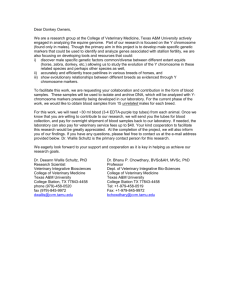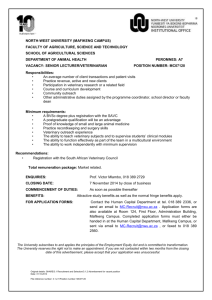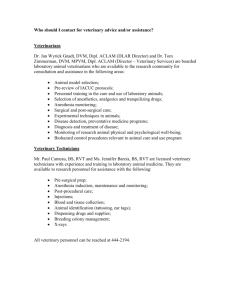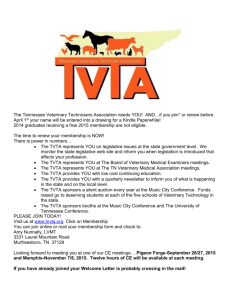Provost`s Council
advertisement
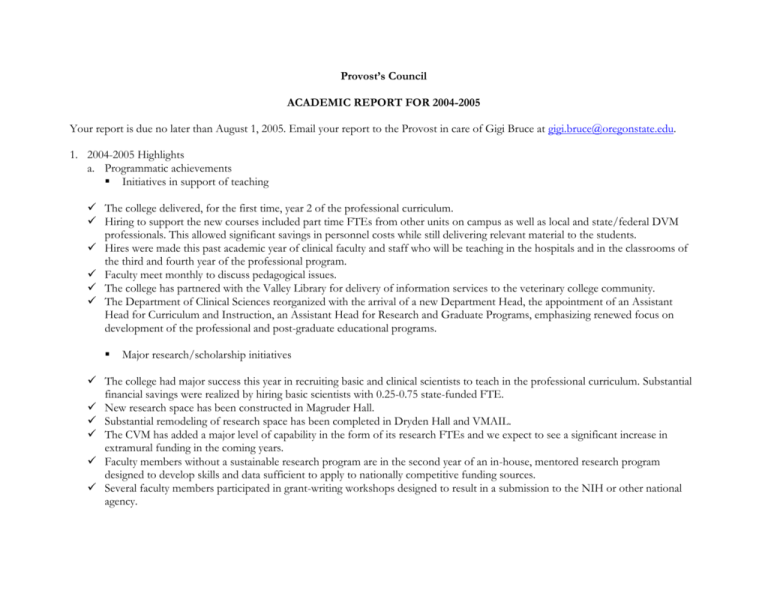
Provost’s Council ACADEMIC REPORT FOR 2004-2005 Your report is due no later than August 1, 2005. Email your report to the Provost in care of Gigi Bruce at gigi.bruce@oregonstate.edu. 1. 2004-2005 Highlights a. Programmatic achievements Initiatives in support of teaching The college delivered, for the first time, year 2 of the professional curriculum. Hiring to support the new courses included part time FTEs from other units on campus as well as local and state/federal DVM professionals. This allowed significant savings in personnel costs while still delivering relevant material to the students. Hires were made this past academic year of clinical faculty and staff who will be teaching in the hospitals and in the classrooms of the third and fourth year of the professional program. Faculty meet monthly to discuss pedagogical issues. The college has partnered with the Valley Library for delivery of information services to the veterinary college community. The Department of Clinical Sciences reorganized with the arrival of a new Department Head, the appointment of an Assistant Head for Curriculum and Instruction, an Assistant Head for Research and Graduate Programs, emphasizing renewed focus on development of the professional and post-graduate educational programs. Major research/scholarship initiatives The college had major success this year in recruiting basic and clinical scientists to teach in the professional curriculum. Substantial financial savings were realized by hiring basic scientists with 0.25-0.75 state-funded FTE. New research space has been constructed in Magruder Hall. Substantial remodeling of research space has been completed in Dryden Hall and VMAIL. The CVM has added a major level of capability in the form of its research FTEs and we expect to see a significant increase in extramural funding in the coming years. Faculty members without a sustainable research program are in the second year of an in-house, mentored research program designed to develop skills and data sufficient to apply to nationally competitive funding sources. Several faculty members participated in grant-writing workshops designed to result in a submission to the NIH or other national agency. Major outreach/engagement initiatives Contact has been made with the Oregon Cattlemen’s Association in regards to partnering to increase the number of veterinary graduates interested in rural practice and to increase the responsiveness of the Veterinary Diagnostic Laboratory to the cattlemen’s needs. The college has signed an MOU with the Department of Agriculture to provide assistance in the case of an animal/foodborne/zoonotic disease emergency. The Veterinary Diagnostic Laboratory is an official part of the National Animal Health Laboratory Network. The College has continued its cooperative educational programs with the Oregon Veterinary Medical Association and will expand its participation in jointly-offered continuing education programs at the local and state level. National/International impact of programs and initiatives The CVM’s growth in human resources and facilities has had a tremendous impact on the national reputation of the college. We have signed all of our choices for faculty positions. We continually receive unsolicited inquiries by qualified academics asking when we anticipate job openings. MOU’s for student exchange and faculty development have been signed with the University of Santo Tomas in Chile, St. George’s University on Grenada, Ross University on St. Kitts and another is pending with the University of Turin, Italy. b. Faculty recognition and awards Faculty continue to serve on NIH study panels and as ad hoc reviewers for grants and manuscripts. Dr. Dan Rockey received the Pfizer Award for Research Excellence. Dr. Chris Cebra received the Norden Distinguished Teacher Award c. Student recognition and awards Over $160K in merit-based scholarships and need-based grants were distributed to the student body this past academic year. 2. Strategic Plan Implementation a. Focus for 2004-2005: Enhancing student success, increasing research and outreach, and enhancing diversity and community For each focus area, list the initiatives undertaken and the outcome at the end of the year (include international dimensions within diversity) Enhancing student success. Student orientation has been expanded to three days. Included in orientation are psychological inventories and an introduction to campus counseling and career services resources. A faculty discussion of student mentoring was conducted. The college reworked its admissions procedures (placing increased emphasis on non-cognitive life skills) meeting three times with Dr. William Sedlacek, campus consultant. Discussions are continuing regarding college admissions procedures. A year long trial was conducted incorporating tablet computers into the classrooms. All classrooms and major laboratories were brought up to OSU IT standards. Elective courses are being expanded as small animal clinical faculty come on board. Increasing research and outreach. Significant numbers of strategic hires have made the college the focus of campus efforts in pathogenic microbiology. Numerous research collaborations are underway campus wide, statewide, nationwide and worldwide that include college personnel. Enhancing diversity and community. With its latest round of faculty hires, the college approaches gender parity and has significant diversity (15%), including international faculty, within its ranks. Nationally, the student body lacks diversity and will continue in this mode until the profession is viewed differently by, and reaches out to, diverse constituencies. There have been considerable obstacles not yet overcome to incorporate more international diversity among our residents and graduate students. These people will be the next generation of faculty. The OUS system and OSU do not have a mechanism for accommodating post-DVM trainees within the educational system as does every other CVM in the country. We have been working with the Dean of the Graduate College, the Provost and other campus resource personnel to effect change but progress has been slow. Provide a brief self-assessment of the unit efforts in the three areas: what worked; areas that need improvement; major barriers Enhancing student success. As the smallest college of veterinary medicine in the nation, our 48 students receive a phenomenal amount of one to one tutelage. Our peer-tutoring program for veterinary students has become a national model as has our “procedures” book to ensure hands-on practical experience prior to graduation. Our partnership with the Oregon Humane Society is another innovative program in experiential student learning. Since our didactic program is largely technology based, some students are at a disadvantage if they cannot afford a wireless portable computer. We have had one donor agree to provide a single scholarship for this purpose. We need assistance from campus offices to promote veterinary medicine as a career to those students, including those that are members of under represented groups, who are interested in professional careers other than private practice (i.e. Public Health Service, Agribusiness, Pathology etc.). A number of professional student summer research experiences (>16) in CVM laboratories have been made available. An internal search for an Associate Dean for Student and Academic Affairs is currently underway to provide innovative leadership for academic programs. Research is being conducted within the college regarding professional student issues (Gelberg S, Gelberg HB. Stress management interventions for veterinary students. J Vet Med Edu 32:23-31, 2005). Increasing research and outreach. Our research potential is becoming limited by the availability of facilities to house faculty and their programs. The college has a small number of senior, non-productive faculty members and faculty members who put their own needs above those of the college and university. One of these persons continually acts at cross-purposes to the standards of scientific conduct to which we as a whole subscribe. This continues to be problematic for the college politically and to internal morale. Outreach activities are severely limited by budget and space. With the increasing public health concerns of zoonotic infections such as mad cow disease, West Nile virus and avian influenza and subsequent testing at the VDL, the CVM has been forced to divert E&G monies for these important diagnostic activities. Carcass disposal, as a result of the threat of mad cow disease testing, is becoming increasingly problematic. The state has not addressed the need for additional resources to support these activities since 1989 and the House of Representatives has proposed a large cut in the VDL budget that will put these public health activities in jeopardy. Outreach activities to farm and animal production enterprises in the state is problematic as the CVM has no extension budget and shares the services of a single (yet to be hired) extension veterinarian with the College of Agricultural Sciences. Enhancing diversity and community. The CVM has created a diversity plan in conjunction with the Director of Community and Diversity at OSU. The college has great diversity among its faculty and seeks to improve its diversity among its post-DVM clinical trainees. OUS and OSU rules and regulations are hindering our ability to admit foreign nationals as trainees. Our training programs include clinical internships and residencies which OSU is unwilling or unable to financially accommodate within the existing classification system. Within the community, the CVM partners with a variety of humane societies to care for abandoned animals and make them more adoptable, while at the same time working to reduce the birth of unwanted puppies and kittens. The most visible of these programs is developing in concert with the Oregon Humane Society in Portland. b. Summarize major unit activities during 2004-2005 that helped promote one or more of the thematic areas This year was characterized by a dramatic and positive change in the culture of the college that resulted in an incredible faculty/staff recruiting campaign. The personnel are in place to achieve excellence in all college programs. 2. Other initiatives and their outcomes [e.g., Faculty/Staff Professional Development Activities] Faculty have been encouraged to present at national meetings at college expense. Each department has a per capita budget for this purpose that is released to faculty based on merit. 4. Scorecard a. Performance on college-level metrics Metric Actuals (AY/FY) College Targets # 2002-03 2003-04 2007-08 $1,236,256 0 N/A 1.4 $1,107,766 0 3.6 $ 1,374,000 100 13 34 0 33 1 48 3 4.6 / 5.1 91.9 100.0 36 / 507 3 / N/A 6.3 / 6.8 89.2 97.9 48 / 659 1 / 12 5.5 / 6.0 100 100 48 / 650 18-Jun 24 / $2,336,356 13 / $829,067 20 / $2,897,000 $825,712 $6,205,394 $950,000 Goal 1: Provide Outstanding Academic Programs 2004-05 Themes: Increase research and outreach Increase diversity 1.1 1.2 1.3 1.4 Expenditures from Grants and Contracts, and Other Sources Invention Disclosures % of Faculty, Staff, and Students Comfortable with Climate for Diversity¹ % of U.S. Minority Students of Total College Enrollment Goal 2: Improve the Teaching and Learning Environment 2004-05 Themes: Improve student success and retention Increase diversity 2.3 2.4 2.6 2.x.1 2.x.2 2.x.3 2.x.4 First Professional (DVM) Degrees Awarded Graduate Degrees Awarded Student Primary Major to Faculty FTE Ratio / Student Course to Faculty FTE Ratio DVM (Doctor of Veterinary Medicine) Graduation Rate (%) First Year Retention Rate First Professional Students Admitted / Applicants Graduate Students Admitted / Applicants Goal 3: Increase Revenues 3.1 Awards from Grants and Contracts (# / $) 3.2 Private Giving Revenue ¹ College of Veterinary Medicine not included in Campus Climate Survey results due to a sample size less than 10. b. Leveraging resources Initiatives to leverage state resources The dollars provided the college to construct a 4 year program have been leveraged three fold into a $24M building program. State money must be sought to update and expand the Veterinary Diagnostic Laboratory to fulfill our public and animal health obligations to the citizens of Oregon. Initiatives to improve administrative efficiencies In spite of a 1/3 increase in student numbers and a doubling of our course offerings, administration within the college has not grown. It remains the smallest, least-funded, most-efficient administration within a college of veterinary medicine. 5. Proposed Goals for 2005-2006, particularly in the areas of Enhancing student success In the coming academic year, we are expanding our offerings of life-skill training to incoming students at orientation and during the 4 year curriculum. The college will be delivering the third year of the professional curriculum for the first time and will be training our students within our own small animal teaching hospital. Our admissions process and student mentoring programs are undergoing review with an eye towards improvement. Increasing research/scholarship and outreach Start up monies and new/remodeled laboratories are being provided college investigators. Construction will begin on clinical research facilities in the large animal addition in early winter. A grant to the NCRR will be resubmitted for completion of shelled research space within the large animal hospital addition. Enhancing diversity and community, including international dimensions The college will be working closely with campus and with national veterinary organizations to increase diversity within the college and the profession. An MOU with at least one additional international institution will be completed in the coming year.


